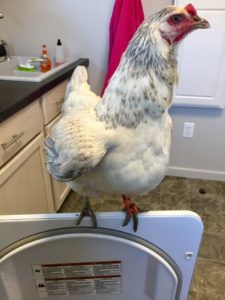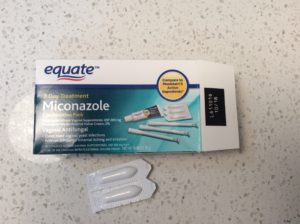Altering your chicken’s living environment and even seasonal boredom can bring with it some unforeseen side effects, including a sour crop. Finding do-it-yourself solutions can help avoid expensive veterinary calls or losing your bird as a result of this disease.
My first experience with this issue was quite interesting. One bird’s case included an added twist I didn’t quite expect. With two of my favorite hens on the sour crop watch list, I knew I had to find something to save them.

Sterling was brought into our indoor infirmary/laundry room for sour crop treatment. In this photo, you can see her distended crop which was full of yeasty, bubbly liquid.
What is a sour crop?
Basically, a sour crop stems from an overgrowth of the wrong kinds of gut flora (fungus), namely yeast, growing in a chicken’s crop. Before long, the exponential growth of this yeast will fill the crop leaving little room for food.
The crop is simply a food storage pouch that makes up the first part of the digestive tract. Food typically spends less than 12 hours in the crop. Each evening, it will be full and semi-firm. By morning, the pouch should be empty and less pronounced.
When a chicken presents with a sour crop, you may notice a slight, sour, yeasty odor on their breath. Their crop will feel very squishy and sound bubbly or gassy upon palpitation.
Some chickens may also present with an odd “ducking” or “twitching” of the head. This is partly in an effort to keep what is in their crop from entering the esophagus. Most likely, your hen or rooster will have little interest in eating because of this fact.
What factors can lead to a sour crop?
In some cases, less access to their summertime forage areas can make many non-edibles look attractive. Chickens tend to pick at anything they can get their beaks on.
This year, I’ve had a few chickens who have started to pluck away at the plastic sheeting covering their pen enclosure. If that wasn’t bad enough, they are also nabbing up hard to digest pieces of straw littering their outside pen.
Anything that can clog up or slow down food moving out of the crop, can be a huge factor in developing a sour crop. Consuming feed that exhibits mold, is yet another contributor.
In my hen Sterling’s case, hard straw bits in her crop prevented them from moving forward into the next stage of digestion. It would empty, but only to the point of those few straw pieces remaining. Because they were slowly breaking down and fermenting in the crop, this allowed the perfect environment for yeast to grow. Any food she was able to eat only added fuel to the fire.
Her digestive system was working overtime trying to digest and pass the straw. She had literally gotten to the point her poo was liquid and pieces of straw…definitely not normal.
Note: If the contents of a bird’s crop are not moving at all, that is something else entirely. An impacted crop is simply that a crop packed full of material so tightly it can’t move forward. This must be treated by other means than I have listed here.
How do you treat a sour crop?
Standard veterinary treatment would be dosing with a round of anti-fungal medication such as Clotrimazole or Fluconazole. As long as the bird is eating, passing feces and drinking; that is likely all it will need.
In extreme cases or in the case of unusual foreign matter, a vet may need to take further steps. This can include vomiting the bird or surgically removing the offending objects.
DIY treatments, on the other hand, can be less invasive and equally as effective. If a case of sour crop is not too severe, yogurt or probiotics can help correct the imbalance of undesirable yeast overgrowth. Not only that, it can help keep things moving through the digestive tract.
For more advanced cases, vomiting a bird can also be done at home. The main purpose is to empty the crop of much of the yeast and food solids. Out with the bad…in with the good.
To vomit a bird you’ll need to understand that a bird simply won’t give up the crop’s contents. They lack the ability to vomit on their own and don’t have a gag reflex.
By turning the bird upside down, you can manually force the contents up and out of the crop. Gently squeezing the crop and massaging upwards from the breastbone towards the head can facilitate the action.
Now, this treatment doesn’t come without its own set of risks. You won’t want to vomit them upside down for too long because the bird needs to breathe. Gasping for breath can easily cause the bird to aspirate vomit matter into their lungs.
Once complete, it is important to provide the bird with plenty of fluids and soft foods that allow easy movement out of the crop. Feed plain active-culture yogurt, probiotics, and water combined with a small amount of apple cider vinegar for a few days.
Once improvement is noted, graduate to watered-down pellet or crumble layer feed and even cooked oatmeal with a small amount of olive oil. The key is to make sure the crop is emptying and not filling full of yeasty bubbles.
If your yeast issue doesn’t clear up, you may have to proceed with medicating with an anti-fungal. You can see if your local feed store carries this or get it prescribed by the vet.
Are There More Treatment Options?
If you are remote or are unable to contact a vet for medication, you can always try an alternative cure I found on a few forum boards. Vaginal yeast infection suppositories were not created for oral consumption but in a pinch, they work. They were designed to kill yeast and are very effective in clearing the overgrowth within a bird’s crop.

With my hen, I used a 3-day treatment that had Miconazole Nitrate as the active ingredient. One suppository was cut into 6 pieces which represented separate doses. Dosing 1-2 times per day by hiding it in yogurt or straight into an open beak was tolerated well.
Results were quickly seen after the first 2 doses. My bird’s crop was no longer distended with foamy contents. Even though she still had hard straw bits in her crop, it seemed to empty well overnight.
Although the forum information stated the treatment use of three entire suppositories, I held off at using just one. After 3 days, I placed Sterling back in the pen with the rest of my flock. She returned to the pellet/crumble layer feed supplemented with grit; however, I did not offer scratch feed for one full week.
In the end, it may take some time for those residual pieces of straw in her crop to break down and move out. If the yeast rears its ugly head once again, I plan on repeating the singular suppository dosage. Until then, I just have to play the waiting game and be vigilant.
I have also read that Clotrimazole in the form of jock itch or athlete’s foot medication has successfully been used to clear a sour crop of yeast. This is one treatment I have not tried personally, but in case of an emergency, it’s good information to have.
In the end, it can pay off to try treatments that are a little out of the ordinary. Sometimes, the benefits far outweigh the risk if you know your chicken is on the downhill slide.
Note: If your hen is being dosed with medication and she is laying eggs, it’s always best to err on the side of caution. Avoiding consumption of the treated bird’s eggs for up to 1-2 weeks after treatment is a good guideline.
Please be advised that any treatment option listed in this article was used solely at my own risk and not recommended by a veterinarian. On this farm, an ill chicken, unless it’s the entire flock, will always be self-treated at home or culled if the illness is too severe.













5 Comments
Thank you so much. I was truly in the weeds with my alpha girl, Carol. Two days into the yeast cream & she’s finally turning a corner. I absolutely would have turned her loose too soon and we probably would’ve lost her. I appreciate you sharing your hard earned wisdom!
One of my chickens has a sour crop for about 4 days and it won’t empty, I’ve massaged it and given many things like Acv and I tried to have her burp it with not much luck. Is there anything else I can do?
Liz, sorry for you bird’s distress (and yours.) You might try a little olive oil to see if you can loosen things up. And keep massaging.
My RIR Seems to be bringing up fluid on her own .This morning it was a brown color and tonight it is sort of a white color. I read on one sight to withhold food and water for 12 hours. And try yogurt and scrambling some eggs.
did you feed your chicken with the use of the medication. What did you feed her along with it and did she have water or anything in her water to aid the process. I caught mine early and she is still eating and not lethargic but I want to see her succeed. vets are closed and I cant find anywhere that sells antifungal around me.